


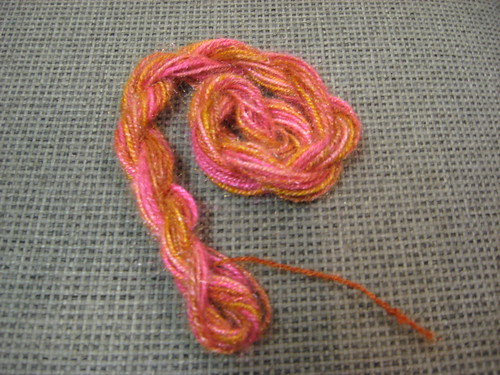 I've been doing a lot lately, but I haven't been blogging about much of it. However, I'm too lazy and it's too late to be writing a big long post, so I'm going to do a picpost.
I've been doing a lot lately, but I haven't been blogging about much of it. However, I'm too lazy and it's too late to be writing a big long post, so I'm going to do a picpost.









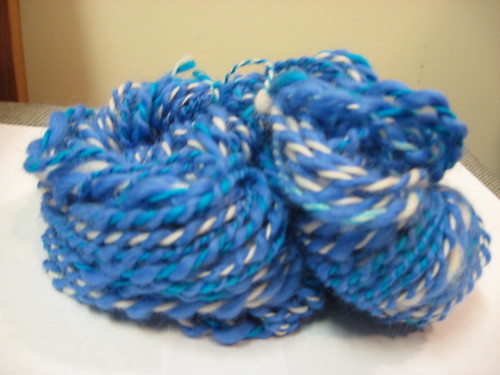 So I did the drawing from the second week, and starrypurplehaze, you are the winner! The yarn to the right is your prize. E-mail me with your address and I'll have this in the mail to you in two shakes of a lamb's tail!
So I did the drawing from the second week, and starrypurplehaze, you are the winner! The yarn to the right is your prize. E-mail me with your address and I'll have this in the mail to you in two shakes of a lamb's tail! But what is my point in all this? Well, if you look at the title, it's supposed to be about crochet hooks. And my point is, until recently, I had been carrying my hooks around in a glasses case. (Hey, it worked and it was compact!) But as part of my SP 12 Swap, Kathleen made me a beautiful crochet case holder, and I've been wanting to show it off. So I gathered up most of my crochet hooks, and made some startling discoveries.
But what is my point in all this? Well, if you look at the title, it's supposed to be about crochet hooks. And my point is, until recently, I had been carrying my hooks around in a glasses case. (Hey, it worked and it was compact!) But as part of my SP 12 Swap, Kathleen made me a beautiful crochet case holder, and I've been wanting to show it off. So I gathered up most of my crochet hooks, and made some startling discoveries.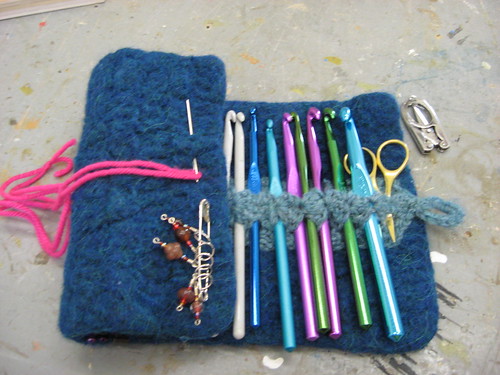
 two, and I have another handspun yarn to show off for you. Take a look! What do you think I should call it? It's bulky and it's got a wonderful squish to it, but I'm debating about a name. Suggestions are welcome. And also this week there will be a mysterious prize! I'll let you know what it is closer to the end of the week.
two, and I have another handspun yarn to show off for you. Take a look! What do you think I should call it? It's bulky and it's got a wonderful squish to it, but I'm debating about a name. Suggestions are welcome. And also this week there will be a mysterious prize! I'll let you know what it is closer to the end of the week.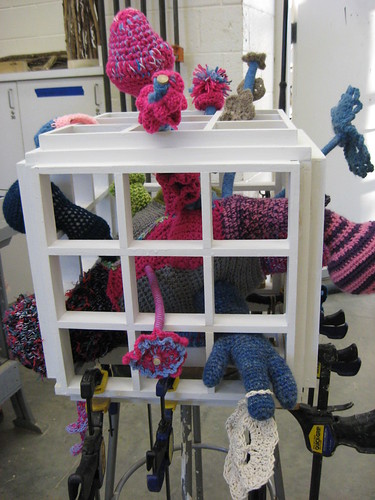
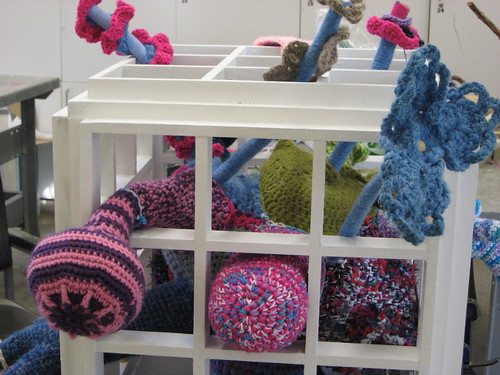 an explosion of color and vibrancy that carried itself over into the final product. While my project started out as an explosion of ideas, the process of constructing it lead it to become part of a greater dialogue about crochet, art and the function of handicrafts in a modern society.
an explosion of color and vibrancy that carried itself over into the final product. While my project started out as an explosion of ideas, the process of constructing it lead it to become part of a greater dialogue about crochet, art and the function of handicrafts in a modern society.There is a vibrant internet community of people who crochet and, being a college student connected to the online world, I follow several different artists who use crochet in their sculpture. Primarily, The Institute for Figuring’s hyperbolic crochet math models, crochet coral reef, and vortex of trash influenced my idea of what crochet could do. It’s exhibits of crochet choral reefs are full of ruffles, branches, and bulbous branch-offs. Its hyperbolic crochet exhibit features ruffles and uneven surfaces which are strangely hypn otic and fascinating to the eye. The Institute for Figuring made me realize that crochet could be something other than functional art.
otic and fascinating to the eye. The Institute for Figuring made me realize that crochet could be something other than functional art.
The Institute also set up a discourse about what crochet could represent, one which I wanted to respond to. The institute takes advantage of crochet’s unique properties. Like crochet, knitting can increase exponentially, but the number of stitches on the needles quickly becomes unmanageable. Crochet, which each stitch being independent of each other, offered the perfect solution. (The Institute for Figuring website) Like The Institute for Figuring, I wanted to enter into the dialogue of using crochet not only because I loved crochet but because it was the most efficient solution to my problem. After engaging in externalization and objectivaion, I was finally ready to transform “structures of the objective world into structures of the subjective consciousness” (Berger). I wanted to add to the dialogue of sculptural crochet, a term coined by Wunderkammer, who was another influence on the advantages of crochet as a sculptural form and tool (SuperNaturale).
In Peter Berger’s essay “Sacred Canopy” he writes that, “Once produced, the tool has a being of its own that cannot be readily changed by those who would employ it. Indeed, the tool may even enforce the logic of its being upon its users, sometimes in a way that may not be particularly agreeable to them.” Crochet is a tool that forces its logic on its users, making those who want to crochet instead of knit create in a certain way. Oftentimes, people who crochet will avoid making certain items (like socks) because crochet does not lend itself well to the construction of those items (crochet socks don’t have much stretch). Like Berger’s man who creates language and then is subject to its rules, by adopting crochet as my craft I am limiting myself in what I can do. Touch Me reacts against these constraints, attempting to take advantage of the limitations of crochet instead of being restrained by them. Peter Schjeldahl describes in his essay “Deacon’s Faith” a conversation between two men. In reply to a question about what the sculpture is, the second man replies, “it’s art. Look at the way it’s put together.” Much of the meaning in this sculpture is derived from the way it’s put together. Using Dr. Seuss-ian forms and a patchwork construction I attempt to give a sense of movement and also a sense of whimsy
the construction of those items (crochet socks don’t have much stretch). Like Berger’s man who creates language and then is subject to its rules, by adopting crochet as my craft I am limiting myself in what I can do. Touch Me reacts against these constraints, attempting to take advantage of the limitations of crochet instead of being restrained by them. Peter Schjeldahl describes in his essay “Deacon’s Faith” a conversation between two men. In reply to a question about what the sculpture is, the second man replies, “it’s art. Look at the way it’s put together.” Much of the meaning in this sculpture is derived from the way it’s put together. Using Dr. Seuss-ian forms and a patchwork construction I attempt to give a sense of movement and also a sense of whimsy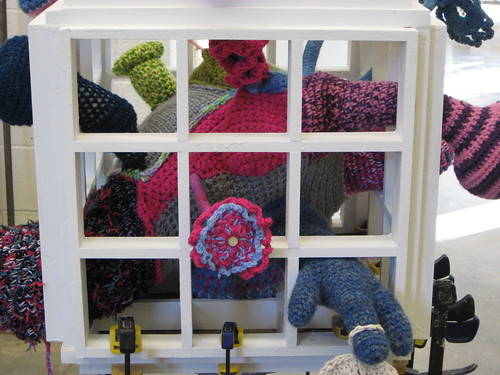 - a wish for what could be and a need to reach beyond the obvious. But the bars of wood- rigid and simply colored, restrain it from going beyond the bounds of its form. While the sculpture might reach outside of the form a little, it is too big to fully escape, just as crochet can go beyond its constraints, but not fully escape them. Glaringly bright and clashing colors give it a sense of childishness, but also violence- a frustration with what is, but also an acceptance.
- a wish for what could be and a need to reach beyond the obvious. But the bars of wood- rigid and simply colored, restrain it from going beyond the bounds of its form. While the sculpture might reach outside of the form a little, it is too big to fully escape, just as crochet can go beyond its constraints, but not fully escape them. Glaringly bright and clashing colors give it a sense of childishness, but also violence- a frustration with what is, but also an acceptance.
Touch Me, or A Rebellion Against the Sampler is part of a discourse on crochet, a celebration and protest of what crochet means to not only me, but to many other people who crochet, and who are frustrated by the discrimination against the lesser-known handicraft. John Thompson writes, “In spoken discourse meaning resides as much in its disjunction, its truncations and dislocations- in a gesture of the hand, the involuntary twitch of a muscle or a barely perceptible flicker of the eye.” Touch Me attempts to capture some of that gesture, some of the sense of discourse surrounding crochet. It, in the ruffles and rapid increases and decreases, invokes other crochet works, referencing what came before. But it also adds something to the discourse with the incorporation of the wooden cage- an open, airy cage, but a cage nonetheless. It makes gives the limitations of crochet a physical form. While the 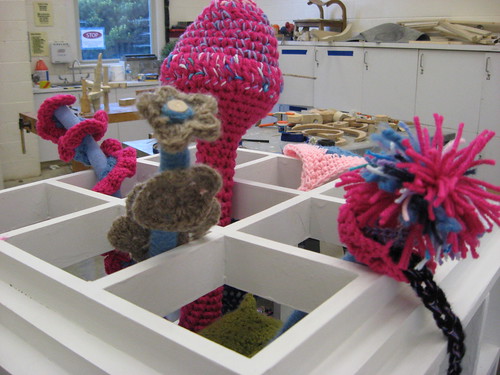 meaning in this sculpture did not come in its conception, the repetitive process of creating stitch after stitch of crochet gave the sculpture meaning as I worked and utilized the advantages and disadvantages of crochet. Works Cited
meaning in this sculpture did not come in its conception, the repetitive process of creating stitch after stitch of crochet gave the sculpture meaning as I worked and utilized the advantages and disadvantages of crochet. Works Cited
Wunderkammer. SuperNatural. 30 September 2008. <http://www.supernaturale.com/articles.html?id=277>.
The Institute for Figuring. Home. 30 September 2008. < http://theiff.org/main.html>.

 : It's inspired by Harry Potter (who I think is very, very Halloween-ish!).
: It's inspired by Harry Potter (who I think is very, very Halloween-ish!).


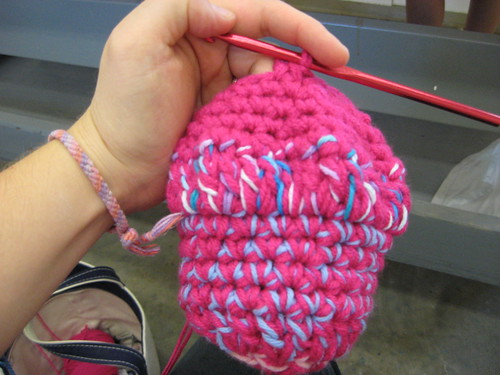
 The self is right under the bed.
The self is right under the bed.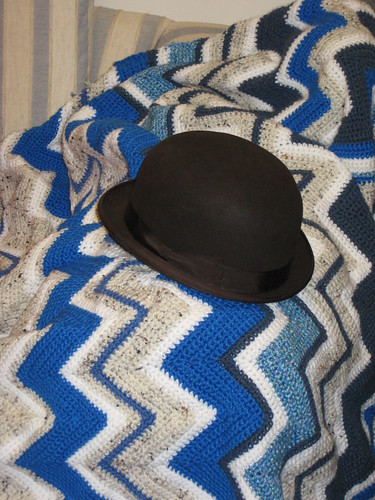
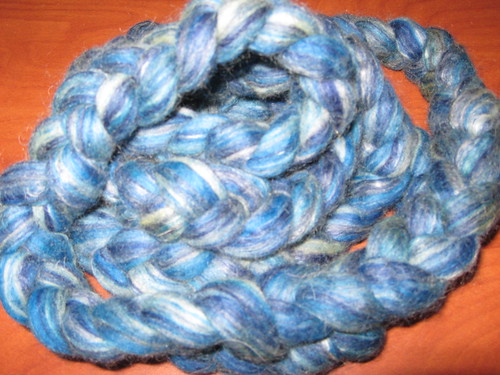
![IMG_2097[1]](http://farm4.static.flickr.com/3155/2550550723_2357304d7f.jpg)
![IMG_2055[1]](http://farm4.static.flickr.com/3113/2535642073_10f7d33bac.jpg)